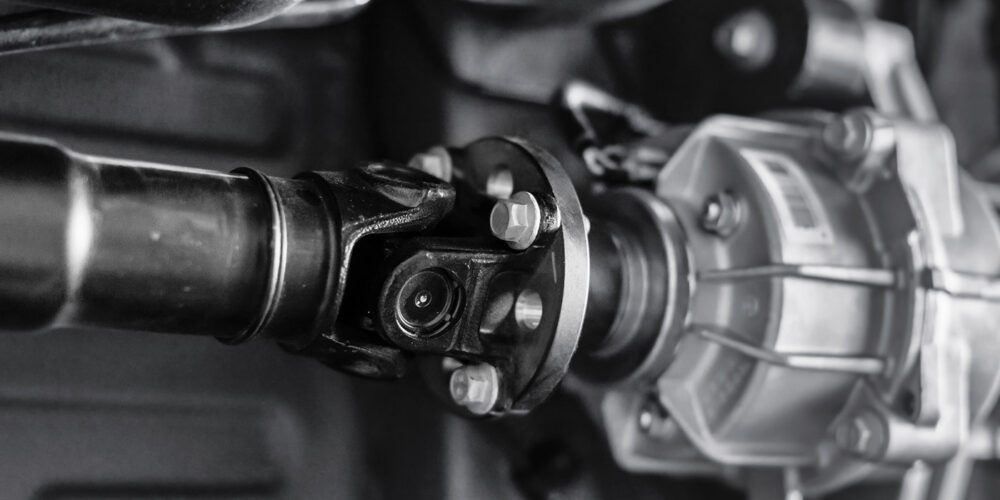Prior to the mainstream production of front-wheel-drive vehicles and independent rear suspension, the drivetrain on practically every vehicle consisted of a transmission, driveshaft and solid rear axle assembly.
Things were simple. Driveshafts had universal joints (U-joints) at each end and if nothing else, most people were familiar with U-joints and had to replace them at one point or another.
The driveshaft was nothing more than a round tube that transferred the power output from the transmission to the differential. At each end was a U-joint that allowed the angle of the driveshaft to change as the suspension moved up and down over bumps, or the drivetrain angles changed under acceleration.
Today, “driveshaft” is another one of a long list of automotive terms often used and confused with other components.
So where did the confusion begin? In simpler days, the rear driveshaft was all there was. Then, four-wheel-drive vehicles began to utilize a short driveshaft that went from the transfer case to the front differential. But it still was a driveshaft.
As independent rear suspension made its way to American automotive design, early systems utilized an even shorter version of a driveshaft to transfer power from the rear differential to each wheel. As opposed to running longitudinally, or front to back, these driveshafts ran latitudinally, or side to side, and since two of them were required for the rear axle assembly, they also got a new name: halfshafts.
Independent rear suspension was already popular on many rear-engine European vehicles, utilizing halfshafts with constant-velocity (CV) joints. As front-wheel drive (FWD) became popular, CV-joint-equipped halfshafts were utilized due to the greater range of motion and smoother operation they offered over U-joints.
Equipped with CV joints, halfshafts utilized on a FWD vehicle became widely known as “CV shafts.” However, terminology differs between people and geographical location. Some refer to CV shafts as “driveshafts,” and the typical longitudinal rear driveshaft is known to many as a “propeller shaft.” Still yet, some call CV shafts “halfshafts,” which now are the most common type of lateral shaft on the rear of all-wheel-drive or rear-wheel-drive independent-suspension vehicles as well as FWD.
Today, CV joints also are utilized in place of U-joints on many longitudinal drive shafts, both for rear-wheel and all-wheel-drive applications. The bottom line is you may have to ask a few questions to make sure you’re talking about the same part as your customer. But that bowl of spaghetti aside, let’s look at some of the basics of the tried-and-true original longitudinal-type driveshaft.
Fancy? No. Important? Yes.
A driveshaft begins as nothing more than a round tube, either steel or aluminum. The tube is cut to the proper dimensions, then the ends are pressed into the tube. The ends may be a yoke, slip yoke, slip shaft or even a CV-joint hub on newer vehicles. There are multiple options depending on the drivetrain and application.
The ends are then welded on, and the shaft is checked and straightened if necessary. U-joints, CV joints or bearings are installed, and the entire assembly is balanced. An important detail to share with your customer is some driveshafts are two- or three-piece shafts (primarily on trucks or vans), and these are balanced and keyed so when installed, care must be taken to install them properly to maintain the balance.
Typically, a driveshaft may last the life of a vehicle, and replacing the joints – especially U-joints – is a common repair. Any time a driveshaft is removed from the vehicle, it should be marked so it can be reinstalled in the same position, which can help prevent any driveline vibrations. When replacing U-joints, it’s important to make sure the caps of the U-joint fit tightly in the yoke. If they fit loose in the ear of the yoke, the yoke is worn or damaged and the driveshaft will need to be replaced.
So, a driveshaft is nothing fancy. It’s a tube with ends. But as mundane as they may seem, it’s an important component, and even more so where high-performance is concerned.
Often overlooked, the combination of too much power and too high of a rotational speed can cause a driveshaft to twist and bend, and ultimately fail. Performance driveshafts differ based on the quality and diameter of the tubing, and the manner in which they are balanced. Aluminum is a common material because of weight savings and the reduction of rotational mass, but it’s ultimately not as strong as steel.
Have you heard of a driveshaft loop? In the event a U-joint breaks, it’s a safety device that keeps the driveshaft from hitting the road and pole-vaulting the car (really) or keeps it from coming through the floorboards. They’re important for any high-horsepower street or race car, where the chance of breaking a U-joint is much higher.
Don’t Forget About Torque Tubes
Think you have driveshafts down? Well, I skipped one. There’s another type you may have heard of called a torque tube. A torque tube almost looks like a traditional driveshaft setup at a glance, but with a closer look, all you can see is that the tube is bolted directly to the transmission and rear differential. Inside is a smaller-diameter solid driveshaft.
Torque tubes were the prevalent type of driveshaft used in early American auto production, and they have their pros and cons depending on the type of vehicle and the suspension. There are many different designs, again depending on vehicle and suspension type. By the early 1960s, the majority of torque-tube drivetrains were replaced by the traditional driveshaft setup. Even so, torque tubes continued to be utilized on various models from economy to high-end sports cars, and they’re still in use today where the benefits play into vehicle design.













